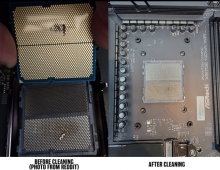
AMD, IBM to Focus on 32nm and 22nm Fabrication Technologies
AMD and IBM has broadened the scope of their technology alliance including early exploratory research of new transistor, interconnect, lithography, and die-to-package connection technologies through 2011.
The agreement marks the first time a member of a technology development alliance will work directly
with IBM's Research Division on R&D, electronic materials, and basic feasibility studies three-to-five
years before commercialization. Further, the extended duration of the alliance makes it one of the
longest IBM currently has with any of its semiconductor alliance associates.
"The industry-leading performance, power-efficiency and function of our AMD64 processors is made possible through a constant, uninterrupted cycle of improvements to our integrated circuit process technologies," said Craig Sander, corporate vice president of technology development at AMD.
"By expanding our successful IBM alliance, we can significantly increase our level of early-stage research, focusing on technologies for the 32nm and 22nm technology generations."
AMD and IBM joined forces in January 2003 to co-develop a 65nm process, although the companies continued their cooperation to take in the 45nm generation too.
AMD is currently preparing its new Dresden plant, Fab 36, for mass-production of 65nm chips on 300mm wafers, next year. The plant is already producing test wafers, AMD has said.
Singapore-based foundry Chartered Semiconductor was signed by AMD in November 2004 as a second source of AMD64 processors, which are likely to be 65nm parts. Chartered has already partnered with IBM and Infineon on the development of 65nm and 45nm chip production techniques.
Research and development will take place in IBM's Watson Research Center in Yorktown Heights, N.Y., the newly announced Center for Semiconductor Research at Albany NanoTech, and at IBM's 300 millimeter manufacturing facility in East Fishkill.
"The industry-leading performance, power-efficiency and function of our AMD64 processors is made possible through a constant, uninterrupted cycle of improvements to our integrated circuit process technologies," said Craig Sander, corporate vice president of technology development at AMD.
"By expanding our successful IBM alliance, we can significantly increase our level of early-stage research, focusing on technologies for the 32nm and 22nm technology generations."
AMD and IBM joined forces in January 2003 to co-develop a 65nm process, although the companies continued their cooperation to take in the 45nm generation too.
AMD is currently preparing its new Dresden plant, Fab 36, for mass-production of 65nm chips on 300mm wafers, next year. The plant is already producing test wafers, AMD has said.
Singapore-based foundry Chartered Semiconductor was signed by AMD in November 2004 as a second source of AMD64 processors, which are likely to be 65nm parts. Chartered has already partnered with IBM and Infineon on the development of 65nm and 45nm chip production techniques.
Research and development will take place in IBM's Watson Research Center in Yorktown Heights, N.Y., the newly announced Center for Semiconductor Research at Albany NanoTech, and at IBM's 300 millimeter manufacturing facility in East Fishkill.





















